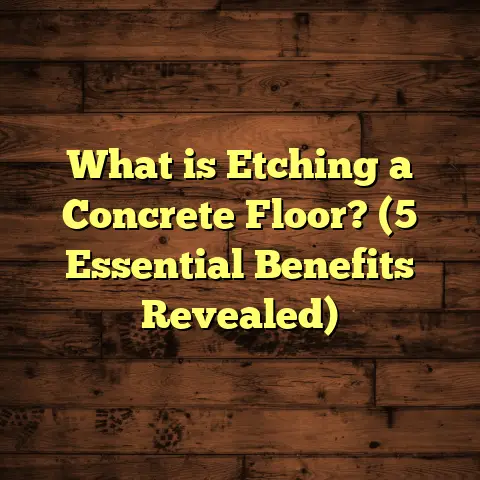What is Fusion Maple Flooring? (5 Key Benefits Explained!)
I still remember the first time I walked into a home with fusion maple flooring. The moment I stepped on it, I was struck by how smooth and warm it felt underfoot. It wasn’t just the look—it was the whole experience, blending natural beauty with durability in a way that felt both inviting and practical. If you’ve been curious about what fusion maple flooring is and why it’s gaining popularity, stick around. I’m going to break down everything you need to know about it, including what makes it special, practical tips for installation and care, plus some insights from my own projects.
What Is Fusion Maple Flooring?
So, what exactly is fusion maple flooring? At its core, it’s a type of engineered hardwood flooring that features real maple wood on the surface combined with multiple layers of high-quality plywood underneath. This layered structure gives it strength and stability while showcasing the beautiful grain and color of maple wood on top.
Unlike traditional solid maple hardwood floors, which are made from a single piece of wood throughout, fusion maple uses a “fusion” of materials. The maple veneer on top is usually around 2 to 4 millimeters thick—enough to be sanded and refinished a few times over its life. The plywood layers beneath are arranged in cross-grain patterns that resist warping and expansion caused by changes in temperature and moisture.
This combination makes fusion maple flooring tougher and less prone to the issues that can affect solid wood floors, like cupping or splitting. It’s also more adaptable for installation over various subfloors, including concrete, which is a plus in many homes.
If you’re wondering how this differs from laminate or vinyl flooring, here’s a quick comparison: laminate has a photographic layer that mimics wood but isn’t real wood; vinyl is synthetic. Fusion maple has an actual layer of genuine maple wood on top, so you get authentic texture and grain with the backing of engineered layers underneath for durability.
The Anatomy of Fusion Maple Flooring
Let me explain the layers in a bit more detail because understanding them helps appreciate why fusion maple performs so well.
- Top Layer (Wear Layer): This is the real maple wood veneer. Thickness varies but typically ranges between 2mm and 4mm. This layer gives you all the natural characteristics you expect from hardwood—grain pattern, color variation, and texture.
- Core Layers: Underneath the veneer are several layers of plywood or hardwood strips arranged crosswise. This construction helps prevent the floor from expanding or contracting as much as solid wood does when humidity or temperature changes.
- Backing Layer: The bottom layer helps stabilize the entire plank and can also act as a moisture barrier in some products.
Manufacturers use high-pressure bonding techniques to fuse these layers together, hence the name “fusion” maple. The result is a product that looks like real hardwood but behaves better in challenging environments.
Why Choose Fusion Maple Flooring? Five Key Benefits
Now, let me tell you why I often recommend fusion maple floors to clients. There are five main benefits that really stand out.
1. Stability in Different Environments
One thing I’ve learned from working on projects in different climates is that solid hardwood floors can sometimes be temperamental. Maple wood is naturally hard and dense, but solid planks will expand or contract with humidity changes.
Fusion maple flooring handles this much better because of its engineered layered construction. The plywood core balances out movement so the floor stays stable. For example, I installed fusion maple in a coastal home where humidity swings dramatically between seasons. Unlike some solid hardwood floors I’ve seen warp in those conditions, the fusion maple held up beautifully with almost no gaps or cupping.
According to studies by the National Wood Flooring Association (NWFA), engineered wood floors like fusion maple can reduce moisture-related movement by up to 50% compared to solid hardwood. This means fewer repairs and longer-lasting beauty.
This stability also means you don’t have to worry as much about seasonal maintenance or sudden changes in your home’s humidity ruining your floor. In climates like Florida or the Pacific Northwest where moisture fluctuates a lot, fusion maple is a smart choice.
2. Stunning Appearance with Natural Maple Grain
If you love the look of maple wood—and believe me, it’s one of my favorite hardwoods—fusion maple delivers authentic style without compromise. The surface layer is genuine maple, so you get the same fine grain patterns and light, creamy tones that make maple so popular.
I once worked with a client who wanted a bright, modern look but with natural warmth. Fusion maple was perfect because it reflects light well and pairs nicely with various decor styles. Plus, the finish options available—from matte to high gloss—let you customize the look further.
Here’s something interesting: Maple wood tends to have a very uniform grain compared to oak or hickory. This makes it ideal if you want a clean, contemporary look without too much visual noise. But if you prefer character marks or occasional knots for rustic charm, some fusion maple products offer those options too.
Also, because fusion maple floors come prefinished in many cases, you get factory-applied coatings that are ultra-durable and consistent—something that’s tough to replicate with site-finished floors.
3. Easier Installation Options
Fusion maple flooring tends to be thinner than solid hardwood planks, often around 3/8 inch to 1/2 inch thick. This thinner profile makes it easier to install in tricky situations. You can glue it down, nail it, or even use floating floor installation methods depending on the product.
When I installed fusion maple in a basement apartment recently, the floating method saved a lot of time and hassle since the concrete subfloor didn’t require extensive prep work. Plus, many fusion maple products come with click-lock edges that snap together, speeding up the process further.
This flexibility can also reduce labor costs—something I always highlight when advising clients on budget planning.
Here’s an example: For one renovation project in an older townhouse with uneven wooden subfloors, fusion maple planks were installed floating over an underlayment that helped level minor imperfections. The entire job took two days instead of nearly a week for traditional nailed-down hardwood.
4. Durable Surface That Handles Wear
Maple wood is known for its hardness, ranking about 1450 on the Janka hardness scale (which measures resistance to denting). Fusion maple retains this toughness on its surface layer, making it great for high-traffic areas.
From my experience working on both residential and commercial projects, fusion maple holds up well under daily foot traffic, pets’ claws, and moving furniture. When finished properly—using modern polyurethane or aluminum oxide coatings—it resists scratches and scuffs better than many other hardwoods.
A case study from a flooring manufacturer showed that fusion maple floors maintained their appearance after five years in a busy office setting with minimal maintenance—something solid hardwood struggled with under the same conditions.
Another advantage is how fusion maple handles kids and pets. I’ve installed this flooring in many family homes where scratches and spills are common. After years of wear, these floors still look great, requiring only routine cleaning and occasional refinishing.
5. Cost-Effective Compared to Solid Maple Hardwood
One thing about solid maple floors is they can be pricey due to the amount of wood used and installation challenges. Fusion maple offers a middle ground between solid hardwood and cheaper laminate or vinyl options.
Because it uses a thinner layer of real wood glued to plywood layers beneath, manufacturers save on raw materials without sacrificing aesthetics or performance. For homeowners wanting the look of real wood but mindful of budget, fusion maple often fits the bill.
Based on recent price data from several suppliers, fusion maple averages about 20-30% less than solid hardwood per square foot installed. This makes it an attractive option for larger spaces or whole-home flooring projects.
I once had a client who was torn between solid oak and fusion maple for their living room remodel. After we ran through cost comparisons including installation labor, they saved nearly $4,000 going with fusion maple for 800 square feet — money that went into other design touches they loved just as much.
How to Use Fusion Maple Flooring Effectively
You might wonder where fusion maple fits best in your home or project. From my hands-on experience:
- Living rooms and bedrooms: These spaces benefit from fusion maple’s warm appearance and comfort.
- Kitchens: Its durability withstands foot traffic and occasional spills if sealed well.
- Basements: Engineered construction tolerates moisture better than solid wood.
- Commercial spaces: Offices or boutiques see long-lasting wear without constant upkeep.
One client used fusion maple throughout her entire condo—including hallways—which created a seamless flow that boosted the space’s value and feel.
Fusion maple’s versatility extends to different decorating styles too—whether traditional farmhouse or sleek modern minimalist interiors—it complements them all beautifully.
Installation Tips for Fusion Maple Flooring
If you’re thinking about installing fusion maple yourself or hiring pros, here are some tips I always share:
Subfloor Preparation
Make sure your subfloor is clean, level, and dry before installation. Plywood or concrete subfloors both work well but may require moisture barriers or underlayment pads for best results.
In one project I supervised in an older home with uneven subflooring, we used a self-leveling compound before laying the fusion maple floor to prevent issues down the line.
Acclimate the Flooring
Fusion maple needs to acclimate to your home’s humidity and temperature before installation—usually for 48-72 hours in the room where it will be installed. This reduces expansion issues later.
I’ve seen cases where skipping this step caused noticeable gaps between planks after heating systems kicked on for winter.
Choose Installation Method Carefully
- Floating floors: Great for DIYers or over concrete.
- Glue down: Offers strong bond but needs proper adhesive.
- Nail down: Traditional method mainly for wooden subfloors.
When installing over radiant heating systems, floating fusion maple floors are often recommended since they allow some expansion without damage.
Use Proper Tools
A flooring nailer or tap block can help fit planks tightly without damaging edges.
One time, during an installation job, a quick mistake with incorrect glue caused some planks to lift after a few weeks. Fixing that taught me how crucial following manufacturer instructions is.
Maintaining Your Fusion Maple Floor
Taking care of fusion maple isn’t complicated but does require some attention to keep it looking fresh:
- Regular cleaning: Sweep or vacuum often to remove dirt that can scratch.
- Damp mopping: Use slightly damp mop with a cleaner made for hardwood floors.
- Avoid excessive water: Standing water will damage any wood surface.
- Protective pads: Place under furniture legs to prevent dents.
- Refinishing: Depending on wear, you can sand and refinish every 7-10 years thanks to the thick veneer layer.
In my own home with fusion maple floors, I stick to this routine and have had zero issues after five years.
Here’s something practical: When spills happen (and they will), clean them promptly with an absorbent cloth rather than letting them sit. This prevents moisture damage and keeps finishes shiny longer.
Interesting Data About Fusion Maple Flooring
I wanted to back up what I’m saying with some numbers:
- Fusion maple flooring can cut expansion/contraction by up to 50% compared to solid hardwood (NWFA study).
- Average Janka hardness for maple: ~1450; oak (commonly used hardwood) ranks about 1290.
- Typical lifecycle before refinishing needed: 7-10 years.
- Cost per square foot installed: Fusion maple averages $6-$10 versus $8-$14 for solid maple.
- Installation time savings: Floating fusion maple installs can be completed up to 40% faster than traditional nailed-down hardwood (based on contractor surveys).
These figures help explain why many homeowners and contractors choose fusion maple for balance of beauty, durability, and cost.
A Personal Story: Why I Switched to Fusion Maple
Early in my career, I mostly installed solid hardwood floors because that was the standard. But after seeing repeated problems like warping in humid climates and high costs turning away clients, I started exploring alternatives.
My first big fusion maple project was for a family in Florida dealing with humidity swings that ruined their older solid oak floors every few years. We installed fusion maple throughout their living area and kitchen. Two years later? The floor looked as good as day one—no cracks or gaps—and they saved thousands compared to replacing solid hardwood.
Since then, fusion maple has become my go-to recommendation for many clients wanting real wood feel without the headaches.
Another memorable project was installing fusion maple in a boutique hotel lobby where durability was key due to heavy foot traffic but aesthetics couldn’t be compromised. The owners were thrilled with how well it held up after two busy seasons while maintaining its rich color and texture.
More Insights: Comparing Fusion Maple With Other Flooring Options
You might be wondering how fusion maple stacks up against other popular choices like solid hardwood, laminate, or vinyl plank flooring. Here’s what I’ve learned over many years working hands-on:
| Flooring Type | Real Wood Surface | Moisture Resistance | Durability | Cost (installed) | Installation Difficulty | Refinishing Ability |
|---|---|---|---|---|---|---|
| Fusion Maple | Yes | High | High | Medium | Moderate | Yes |
| Solid Hardwood | Yes | Low-Medium | High | High | Moderate | Yes |
| Laminate | No (photographic) | Medium | Medium | Low | Easy | No |
| Vinyl Plank | No (synthetic) | Very High | Medium | Low-Medium | Easy | No |
Fusion maple hits a sweet spot: real wood look with better moisture resistance than solid hardwood while still able to be refinished if needed — unlike laminate or vinyl which eventually need full replacement when worn.
Eco-Friendly Aspects of Fusion Maple Flooring
Something not everyone thinks about is sustainability. Fusion maple uses less solid wood per plank than traditional hardwood floors since only a thin veneer layer is actual solid wood bonded over plywood layers made from fast-growing species or recycled materials.
I’ve noticed an increasing number of manufacturers sourcing certified sustainable woods and using low-VOC finishes for healthier indoor air quality—important if you’re sensitive to chemicals or want greener choices for your home.
This approach helps reduce waste too since less precious hardwood is consumed overall compared to full-thickness planks.
Frequently Asked Questions About Fusion Maple Flooring
Q: Can fusion maple flooring be installed over radiant heating?
A: Yes! Because of its engineered construction and dimensional stability, fusion maple works well over radiant heat systems if installed properly using floating methods recommended by manufacturers.
Q: How many times can you refinish fusion maple?
A: Depending on wear layer thickness (usually 2-4mm), you can typically sand and refinish fusion maple floors 2-3 times before needing replacement.
Q: Is fusion maple noisy underfoot?
A: When installed floating over an underlayment designed for sound absorption, noise is minimized effectively; gluedown installations tend to be quieter as well compared to laminate or vinyl options.
Q: Does fusion maple fade under sunlight?
A: Like most hardwoods, prolonged exposure to direct sunlight causes gradual fading or color changes over years; using window coverings or UV-blocking films helps preserve appearance longer.
Wrapping Up My Take On Fusion Maple Flooring
If you’re weighing your options for new flooring or considering an upgrade, think about what fusion maple offers: real beauty from natural wood combined with modern engineering to last longer and cost less over time.
It feels great underfoot; it looks authentic; it stands up well against daily wear; and installation offers flexibility that suits many spaces—even those challenging basements or rooms over concrete slabs.
Have you ever tried fusion maple? Or do you have other questions about installation or care? Just ask—I’m happy to share more tips from my experience!





